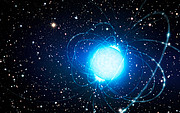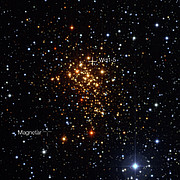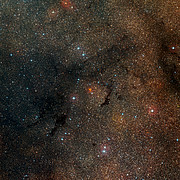Press Release
Magnetar Formation Mystery Solved?
14 May 2014
Magnetars are the bizarre super-dense remnants of supernova explosions. They are the strongest magnets known in the Universe — millions of times more powerful than the strongest magnets on Earth. A team of European astronomers using ESO’s Very Large Telescope (VLT) now believe they’ve found the partner star of a magnetar for the first time. This discovery helps to explain how magnetars form — a conundrum dating back 35 years — and why this particular star didn’t collapse into a black hole as astronomers would expect.
When a massive star collapses under its own gravity during a supernova explosion it forms either a neutron star or black hole. Magnetars are an unusual and very exotic form of neutron star. Like all of these strange objects they are tiny and extraordinarily dense — a teaspoon of neutron star material would have a mass of about a billion tonnes — but they also have extremely powerful magnetic fields. Magnetar surfaces release vast quantities of gamma rays when they undergo a sudden adjustment known as a starquake as a result of the huge stresses in their crusts.
The Westerlund 1 star cluster [1], located 16 000 light-years away in the southern constellation of Ara (the Altar), hosts one of the two dozen magnetars known in the Milky Way. It is called CXOU J164710.2-455216 and it has greatly puzzled astronomers.
“In our earlier work (eso1034) we showed that the magnetar in the cluster Westerlund 1 (eso0510) must have been born in the explosive death of a star about 40 times as massive as the Sun. But this presents its own problem, since stars this massive are expected to collapse to form black holes after their deaths, not neutron stars. We did not understand how it could have become a magnetar,” says Simon Clark, lead author of the paper reporting these results.
Astronomers proposed a solution to this mystery. They suggested that the magnetar formed through the interactions of two very massive stars orbiting one another in a binary system so compact that it would fit within the orbit of the Earth around the Sun. But, up to now, no companion star was detected at the location of the magnetar in Westerlund 1, so astronomers used the VLT to search for it in other parts of the cluster. They hunted for runaway stars — objects escaping the cluster at high velocities — that might have been kicked out of orbit by the supernova explosion that formed the magnetar. One star, known as Westerlund 1-5 [2], was found to be doing just that.
“Not only does this star have the high velocity expected if it is recoiling from a supernova explosion, but the combination of its low mass, high luminosity and carbon-rich composition appear impossible to replicate in a single star — a smoking gun that shows it must have originally formed with a binary companion,” adds Ben Ritchie (Open University), a co-author on the new paper.
This discovery allowed the astronomers to reconstruct the stellar life story that permitted the magnetar to form, in place of the expected black hole [3]. In the first stage of this process, the more massive star of the pair begins to run out of fuel, transferring its outer layers to its less massive companion — which is destined to become the magnetar — causing it to rotate more and more quickly. This rapid rotation appears to be the essential ingredient in the formation of the magnetar’s ultra-strong magnetic field.
In the second stage, as a result of this mass transfer, the companion itself becomes so massive that it in turn sheds a large amount of its recently gained mass. Much of this mass is lost but some is passed back to the original star that we still see shining today as Westerlund 1-5.
“It is this process of swapping material that has imparted the unique chemical signature to Westerlund 1-5 and allowed the mass of its companion to shrink to low enough levels that a magnetar was born instead of a black hole — a game of stellar pass-the-parcel with cosmic consequences!” concludes team member Francisco Najarro (Centro de Astrobiología, Spain).
It seems that being a component of a double star may therefore be an essential ingredient in the recipe for forming a magnetar. The rapid rotation created by mass transfer between the two stars appears necessary to generate the ultra-strong magnetic field and then a second mass transfer phase allows the magnetar-to-be to slim down sufficiently so that it does not collapse into a black hole at the moment of its death.
Notes
[1] The open cluster Westerlund 1 was discovered in 1961 from Australia by Swedish astronomer Bengt Westerlund, who later moved from there to become ESO Director in Chile (1970–74). This cluster is behind a huge interstellar cloud of gas and dust, which blocks most of its visible light. The dimming factor is more than 100 000, and this is why it has taken so long to uncover the true nature of this particular cluster.
Westerlund 1 is a unique natural laboratory for the study of extreme stellar physics, helping astronomers to find out how the most massive stars in the Milky Way live and die. From their observations, the astronomers conclude that this extreme cluster most probably contains no less than 100 000 times the mass of the Sun, and all of its stars are located within a region less than 6 light-years across. Westerlund 1 thus appears to be the most massive compact young cluster yet identified in the Milky Way galaxy.
All the stars so far analysed in Westerlund 1 have masses at least 30–40 times that of the Sun. Because such stars have a rather short life — astronomically speaking — Westerlund 1 must be very young. The astronomers determine an age somewhere between 3.5 and 5 million years. So, Westerlund 1 is clearly a newborn cluster in our galaxy.
[2] The full designation for this star is Cl* Westerlund 1 W 5.
[3] As stars age, their nuclear reactions change their chemical make-up — elements that fuel the reactions are depleted and the products of the reactions accumulate. This stellar chemical fingerprint is first rich in hydrogen and nitrogen but poor in carbon and it is only very late in the lives of stars that carbon increases, by which point hydrogen and nitrogen will be severely reduced — it is thought to be impossible for single stars to be simultaneously rich in hydrogen, nitrogen and carbon, as Westerlund 1-5 is.
More information
The research presented in this ESO Press Release will soon appear in the research journal Astronomy and Astrophysics (“A VLT/FLAMES survey for massive binaries in Westerlund 1: IV.Wd1-5 binary product and a pre-supernova companion for the magnetar CXOU J1647-45” by J. S. Clark et al.). The same team published a first study of this object in 2006 (“A Neutron Star with a Massive Progenitor in Westerlund 1” by M. P. Muno et al., Astrophysical Journal, 636, L41).
The team is composed of Simon Clark and Ben Ritchie (The Open University, UK), Francisco Najarro (Centro de Astrobiología, Spain), Norbert Langer (Universität Bonn, Germany, and Universiteit Utrecht, the Netherlands) and Ignacio Negueruela (Universidad de Alicante, Spain).
The astronomers used the FLAMES instrument on ESO’s Very Large Telescope at Paranal, Chile to study the stars in the Westerlund 1 cluster.
ESO is the foremost intergovernmental astronomy organisation in Europe and the world’s most productive ground-based astronomical observatory by far. It is supported by 15 countries: Austria, Belgium, Brazil, Czechia, Denmark, France, Finland, Germany, Italy, the Netherlands, Portugal, Spain, Sweden, Switzerland and the United Kingdom. ESO carries out an ambitious programme focused on the design, construction and operation of powerful ground-based observing facilities enabling astronomers to make important scientific discoveries. ESO also plays a leading role in promoting and organising cooperation in astronomical research. ESO operates three unique world-class observing sites in Chile: La Silla, Paranal and Chajnantor. At Paranal, ESO operates the Very Large Telescope, the world’s most advanced visible-light astronomical observatory and two survey telescopes. VISTA works in the infrared and is the world’s largest survey telescope and the VLT Survey Telescope is the largest telescope designed to exclusively survey the skies in visible light. ESO is the European partner of a revolutionary astronomical telescope ALMA, the largest astronomical project in existence. ESO is currently planning the 39-metre European Extremely Large optical/near-infrared Telescope, the E-ELT, which will become “the world’s biggest eye on the sky”.
Links
Contacts
Simon Clark
The Open University
Milton Keynes, United Kingdom
Tel: +44 207 679 4372
Email: jsc@star.ucl.ac.uk
Richard Hook
ESO, La Silla, Paranal and E-ELT Press Officer
Garching bei München, Germany
Tel: +49 89 3200 6655
Cell: +49 151 1537 3591
Email: rhook@eso.org
About the Release
| Release No.: | eso1415 |
| Name: | CXOU J164710.2-455216 |
| Type: | Local Universe : Star : Evolutionary Stage : Neutron Star : Magnetar |
| Facility: | Very Large Telescope |
| Instruments: | FLAMES |
| Science data: | 2014A&A...565A..90C |
Our use of Cookies
We use cookies that are essential for accessing our websites and using our services. We also use cookies to analyse, measure and improve our websites’ performance, to enable content sharing via social media and to display media content hosted on third-party platforms.
ESO Cookies Policy
The European Organisation for Astronomical Research in the Southern Hemisphere (ESO) is the pre-eminent intergovernmental science and technology organisation in astronomy. It carries out an ambitious programme focused on the design, construction and operation of powerful ground-based observing facilities for astronomy.
This Cookies Policy is intended to provide clarity by outlining the cookies used on the ESO public websites, their functions, the options you have for controlling them, and the ways you can contact us for additional details.
What are cookies?
Cookies are small pieces of data stored on your device by websites you visit. They serve various purposes, such as remembering login credentials and preferences and enhance your browsing experience.
Categories of cookies we use
Essential cookies (always active): These cookies are strictly necessary for the proper functioning of our website. Without these cookies, the website cannot operate correctly, and certain services, such as logging in or accessing secure areas, may not be available; because they are essential for the website’s operation, they cannot be disabled.
Functional Cookies: These cookies enhance your browsing experience by enabling additional features and personalization, such as remembering your preferences and settings. While not strictly necessary for the website to function, they improve usability and convenience; these cookies are only placed if you provide your consent.
Analytics cookies: These cookies collect information about how visitors interact with our website, such as which pages are visited most often and how users navigate the site. This data helps us improve website performance, optimize content, and enhance the user experience; these cookies are only placed if you provide your consent. We use the following analytics cookies.
Matomo Cookies:
This website uses Matomo (formerly Piwik), an open source software which enables the statistical analysis of website visits. Matomo uses cookies (text files) which are saved on your computer and which allow us to analyze how you use our website. The website user information generated by the cookies will only be saved on the servers of our IT Department. We use this information to analyze www.eso.org visits and to prepare reports on website activities. These data will not be disclosed to third parties.
On behalf of ESO, Matomo will use this information for the purpose of evaluating your use of the website, compiling reports on website activity and providing other services relating to website activity and internet usage.
Matomo cookies settings:
Additional Third-party cookies on ESO websites: some of our pages display content from external providers, e.g. YouTube.
Such third-party services are outside of ESO control and may, at any time, change their terms of service, use of cookies, etc.
YouTube: Some videos on the ESO website are embedded from ESO’s official YouTube channel. We have enabled YouTube’s privacy-enhanced mode, meaning that no cookies are set unless the user actively clicks on the video to play it. Additionally, in this mode, YouTube does not store any personally identifiable cookie data for embedded video playbacks. For more details, please refer to YouTube’s embedding videos information page.
Cookies can also be classified based on the following elements.
Regarding the domain, there are:
- First-party cookies, set by the website you are currently visiting. They are stored by the same domain that you are browsing and are used to enhance your experience on that site;
- Third-party cookies, set by a domain other than the one you are currently visiting.
As for their duration, cookies can be:
- Browser-session cookies, which are deleted when the user closes the browser;
- Stored cookies, which stay on the user's device for a predetermined period of time.
How to manage cookies
Cookie settings: You can modify your cookie choices for the ESO webpages at any time by clicking on the link Cookie settings at the bottom of any page.
In your browser: If you wish to delete cookies or instruct your browser to delete or block cookies by default, please visit the help pages of your browser:
Please be aware that if you delete or decline cookies, certain functionalities of our website may be not be available and your browsing experience may be affected.
You can set most browsers to prevent any cookies being placed on your device, but you may then have to manually adjust some preferences every time you visit a site/page. And some services and functionalities may not work properly at all (e.g. profile logging-in, shop check out).
Updates to the ESO Cookies Policy
The ESO Cookies Policy may be subject to future updates, which will be made available on this page.
Additional information
For any queries related to cookies, please contact: pdprATesoDOTorg.
As ESO public webpages are managed by our Department of Communication, your questions will be dealt with the support of the said Department.






